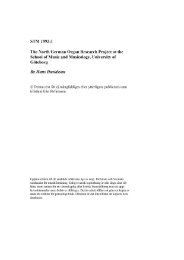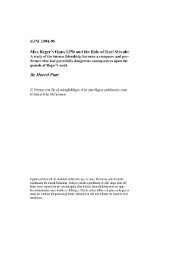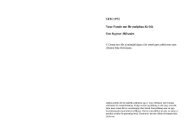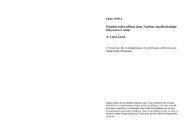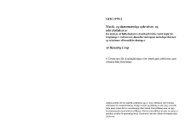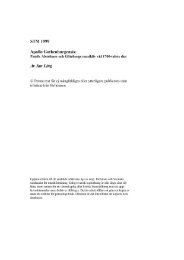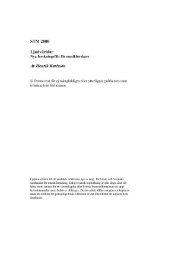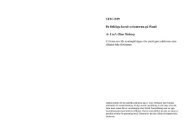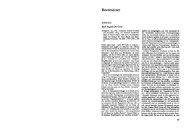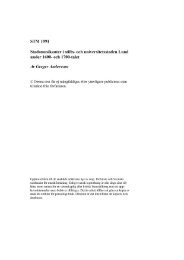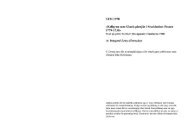Nicolai
Nicolai
Nicolai
Create successful ePaper yourself
Turn your PDF publications into a flip-book with our unique Google optimized e-Paper software.
ausser der Freude am Aufbau stets noch etwas ganz anderes darin finden: die im<br />
hingegebenen Hören selbst sich vollziehende Erhebung, und zwar echte, seelische<br />
Erhebung, die wir als ein Enthobensein in eine andere Welt, eine solche der<br />
Reinheit und Grösse, empfinden.” (P. 200.)<br />
We experience this ”seelische Erhebung” in an objective form-as belonging<br />
to the music; as having being in the music-and yet as a thrilling in our inmost<br />
being. All designations for this are much too general: “Wir sagen etwa: ’das<br />
Feierliche’ oder ’das Erhabene’, die ’dunkle Tiefe’, das ’Strahlende’, das ’Hin-<br />
reisende’, das ’Aufgeregte’, oder das ’Abgeklärte’ . . . Aber man sieht leicht, das<br />
sind alles nur Bilder, und zwar schwache Bilder. Denn es handelt sich hier nicht<br />
um blasse Anklänge, sondern um mächtige, wahrhaft die Seelen ergreifende Ge-<br />
walt der Musik-eine Gewalt, die mitreisst und die Seele des Hörenden erfüllt, und<br />
dennoch im Tonwerk ihm gegenständlich gegenüber bleibt und die ästhetische<br />
Distanz wahrt.” (Pp. 200-201.) All such characterizations are only feeble de-<br />
scriptions of the mystery of the musical work of art. Indeed, the inner strata are of<br />
primary importance. Here the sounds let the innermost and unutterable life of<br />
the soul appear.<br />
Moreover, music is genuine revelation (Offenbarung)-a revelation which can<br />
be expressed in no other language: ”sie ist Verkundigung und zwar durch Er-<br />
weckung der Seele des Hörenden-zum Mitgehen, Mitschwingen, zu innerster<br />
Lebendigkeit; Anteilgabe am ungreifbaren Empfinden.” (P. 201.)<br />
All works of art require of the viewer an inner act of accomplishment (Mit-<br />
vollziehen). Painting and sculpture require that the viewer ”see” as the artist sees;<br />
poetry requires that the hearer or reader imagine as the poet imagines. In music,<br />
however, the main thing is the ”Erfasstsein” and ”Mitgerissensein”: ”subjectiv ge-<br />
sehen, kann man es so schildern, dass das eigene Seelenleben von der Bewegung<br />
des Tonwerkes ganz aufgenommen und in seinen Bewegungsmodus hineingezogen<br />
wird ... die Musik dringt gleichsam in den Hörer ein und wird im Hören die<br />
seine.” (Pp. 201-202.) Music has an unusual power of uniting people-as<br />
exemplified in the well-known ”phenomenon of the concert hall”. Here the au-<br />
dience as a whole can experience the music, with all individuality dissolved. This<br />
phenomenon is observable especially at concerts of truly great artists. ”Wohl haben<br />
alle Künste etwas von dieser verschmelzenden Macht: sie stellen die Seelen um,<br />
richten sie aus, stimmen sie gleich. Aber keine hat es in dem Masse wie die<br />
Musik.” (P. 201.)<br />
The ego of the listener is dissolved in the music-and yet the music remains<br />
objective. Here lies an antinomy. And how can the inner strata, in which we<br />
feel ourselves enraptured, at the same time remain an object of our observation?<br />
There are two ways of enjoying music. In the one the listener is simply over-<br />
whelmed in the movement of the music. This is what Nietzsche called the ’‘Zer-<br />
fliessen in Tristan-Stimmung”. Such a listener misses the structural fine points.<br />
He makes it easy for himself. In the other way the listener gives attention to the<br />
structure of the musical work and masters the complicated whole. Only the latter<br />
type of listening can be called strictly aesthetical enjoyment: ”Nur sie dringt<br />
wirklich ein-durchläuft die ganze Reihe der Schichten und würdigt die Kompo-<br />
sition.” The first type, however, skips over the structural outer strata, ”wühlt sich<br />
von vornherein in die billigeren Gefühlstöne ein und endet im Selbstgenuss der<br />
eigenen Gefühle, des angeregten Seelenzustandes”. (P. 202.) Thus the aesthetical<br />
relationship is invalidated or very seriously disturbed. Hartmann calls Iisteners<br />
who have this musical ”pseudo attitude” ”Schwelger” (gluttons). On the other<br />
hand, ”Die ästhetisch richtige Einstellung. . . greift nicht, verleitet durch be-<br />
stimmte ’Effekte’, vor, sondern geht Schritt für Schritt mit dem Komponisten,<br />
lässt im inneren Hören den Aufbau des Werkes entstehen und erst an diesem<br />
erscheint ihr das Seelische...” (P. 203).<br />
The antinomy is resolved in this way: the inner strata move the listener and<br />
let him be one with the music in enjoyment; the outer strata are objects of<br />
observation and direct the listener toward an observing attitude.<br />
Hartmann discusses the important and difficult question of how sounds and<br />
sound-sequences let the inner strata appear-or in other words, how music expresses<br />
what is innermost and unutterable in the soul. Tones and sounds arc<br />
indeed something different from human emotions.<br />
Upon closer scrutiny, however, the world of sounds on the one hand and the<br />
world of the emotions on the other are not found to be so heterogeneous as they<br />
seem at first glance. Both are immaterial (unräumlich, undinglich); both are in<br />
flux, transition, and movement. Both develop in stimulation and calming down;<br />
tension and resolution. If there is any medium which can express emotional being,<br />
it should be of the same kind: it ought not to produce in its formations things or<br />
bodies; it should not be a thing-but ”Vollzug”. It must be flowing and in movement<br />
over time, and must be able ro delineate the dynamics of emotional processes.<br />
”Dazu ist in einzigartiger Weise die Welt der Klänge und Klangfolgen befähigt:<br />
in ihr ist alles Bewegung, alles Erregung und Beschwichtigung, ein Wogen und<br />
Schwellen, Abschwellen und zartes Verklingen, leises Raunen und Flüstern oder<br />
dunkles Grollen; wildes Brausen, Stürmen, Entfliehen und Jagen, sowie Bändigung<br />
der entfesselten Gewalten in der musikalischen Form.” (P. 204.)<br />
The arts of the optical sense do not possess these dynamics in the degree that<br />
music does, because they are dependent on the seeing of things. Moreover, ”Zweitens<br />
gibt es in den tonischen Elementen der Musik einen affektiven Gehalt, der<br />
weit stärker ist als der in den Elementen des optischen Sinnes” (p. 204). There<br />
is an emotional element in perception, which is usually repressed in the practical,<br />
everyday life, but which comes to the fore in the aesthetical attitude. And this<br />
emotional element is more prominent in the sense of hearing than in sight. ”Dafür<br />
spricht schon das reich differenzierte Gepräge der menschlichen Stimme, der wir,<br />
ohne es uns klar bewusst zu machen, mit grosser Feinheit charakterliche Züge<br />
der sprechenden Person oder auch ihren augenblicklichen Gemütszustand ’anhören’-und<br />
zwar relativ unabhängig vom Inhalt der Rede.” (P. 204.) Music<br />
intensifies these emotional elements by means of timbre, melody, and harmony.<br />
I will quote in full Hartmann’s enumeration and explanation of the inner<br />
strata (p. 205):<br />
1) diejenige des unmittelbaren Mitschwingens des Hörenden. Sie beginnt schon<br />
im Wiegen der Tanzmusik, ist aber wohl aller Musik eigen. Ihre Wirkung



